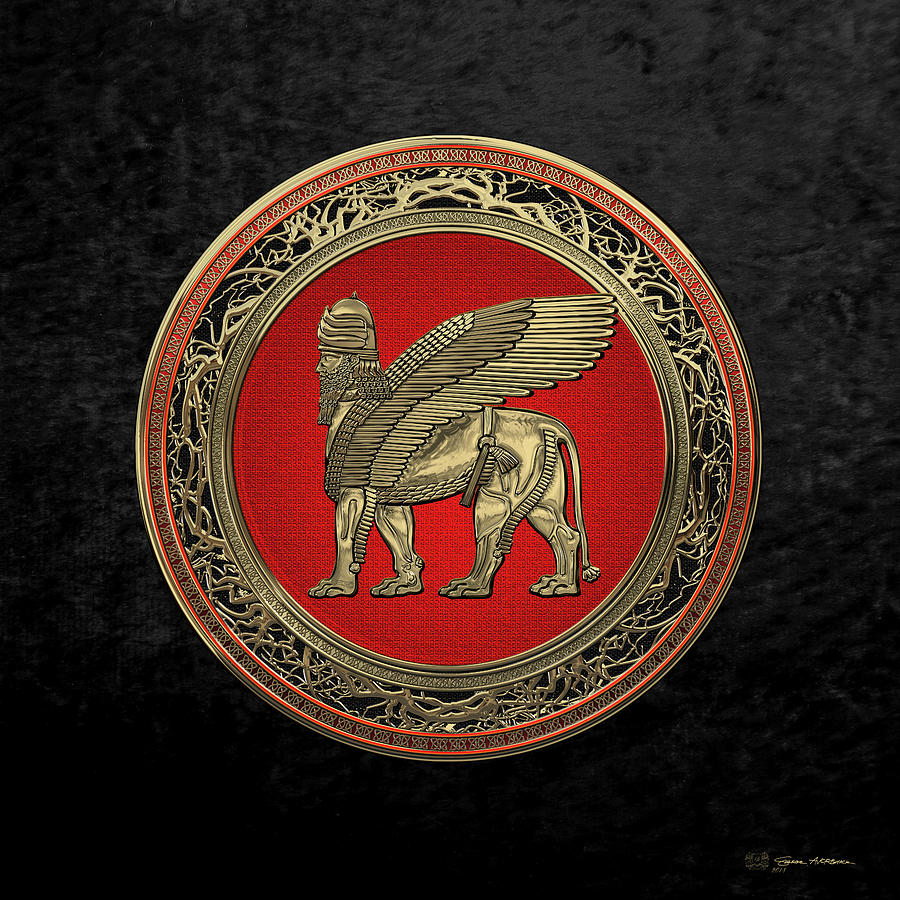
Assyrian Winged Lion - Gold Lamassu over Black Velvet

by Serge Averbukh
Buy the Original Digital Art
Price
$3,500
Dimensions
48.000 x 48.000 inches
This original digital art is currently for sale. At the present time, originals are not offered for sale through the Serge Averbukh - Website secure checkout system. Please contact the artist directly to inquire about purchasing this original.
Click here to contact the artist.
Title
Assyrian Winged Lion - Gold Lamassu over Black Velvet
Artist
Serge Averbukh
Medium
Digital Art - Digital Painting
Description
Introducing ‘Treasures of Mesopotamia’ Collection by Serge Averbukh, showcasing new media paintings of various historical artifacts and symbols from the region. Here you will find pieces featuring Assyrian Winged Lion - Gold Lamassu over Black Velvet.
Mesopotamia is a historical region in West Asia situated within the Tigris–Euphrates river system, in modern days roughly corresponding to most of Iraq plus Kuwait, the eastern parts of Syria, Southeastern Turkey, and regions along the Turkish–Syrian and Iran–Iraq borders.
Assyria was a major Mesopotamian kingdom and empire of the ancient Near East and the Levant. It existed as a state from perhaps as early as the 25th century BC in the form of the Assur city-state, until its collapse between 612 BC and 609 BC, spanning the Early to Middle Bronze Age through to the late Iron Age. From the end of the seventh century BC to the mid-seventh century AD, it survived as a geopolitical entity, for the most part ruled by foreign powers, although a number of Neo-Assyrian states arose at different times during the Parthian and early Sasanian Empires between the mid-second century BC and late third century AD, a period which also saw Assyria become a major centre of Syriac Christianity and the birthplace of the Church of the East. Centered on the Tigris in Upper Mesopotamia (modern northern Iraq, northeastern Syria, southeastern Turkey and the northwestern fringes of Iran), the Assyrians came to rule powerful empires at several times. Making up a substantial part of the greater Mesopotamian "cradle of civilization", which included Sumer, the Akkadian Empire, and Babylonia, Assyria was at the height of technological, scientific and cultural achievements for its time. At its peak, the Assyrian empire stretched from Cyprus and the East Mediterranean to Iran, and from what is now Armenia and Azerbaijan in the Caucasus, to the Arabian Peninsula, Egypt and eastern Libya.
A lamassu, plural lumasi (Sumerian: dlammar; Akkadian: lamassu; sometimes called a lamassus) is an Assyrian protective deity, often depicted as having a human's head, a body of a bull or a lion, and bird's wings. In some writings, it is portrayed to represent a female deity. A less frequently used name is shedu (Sumerian: dalad; Akkadian: shedu) which refers to the male counterpart of a lamassu. The Lammasu or Lumasi represent the zodiacs, parent-stars or constellations. The Lumasi represent the zodiacs, parent-stars, or constellations. They are depicted as protective deities because they encompass all life within them. To protect houses, the lumasi were engraved in clay tablets, which were then buried under the door's threshold. They were often placed as a pair at the entrance of palaces. At the entrance of cities, they were sculpted in colossal size, and placed as a pair, one at each side of the door of the city, that generally had doors in the surrounding wall, each one looking towards one of the cardinal points. In the Sumerian Epic of Gilgamesh they are depicted as physical deities as well, which is where the Lammasu iconography originates, these deities could be microcosms of their microcosmic zodiac, parent-star, or constellation. Although "lamassu" had a different iconography and portrayal in Sumerian culture, the terms "lamassu", "alad", and '"shedu" evolved throughout the Assyro-Akkadian culture from the Sumerian culture to denote the Assyrian-winged-man-bull symbol and statues during the Neo-Assyrian empire. Female lumasi were called "apsasu".
Uploaded
February 3rd, 2018
Statistics
Viewed 3,314 Times - Last Visitor from New York, NY on 04/18/2024 at 12:29 PM
Embed
Share
Sales Sheet
Comments
There are no comments for Assyrian Winged Lion - Gold Lamassu over Black Velvet. Click here to post the first comment.























































